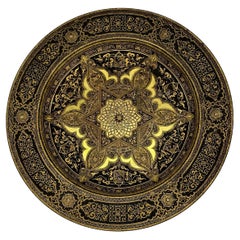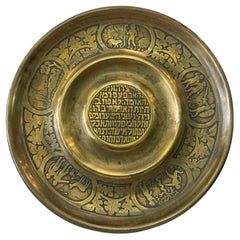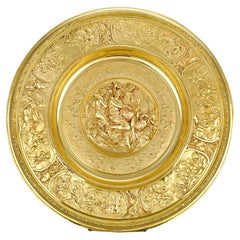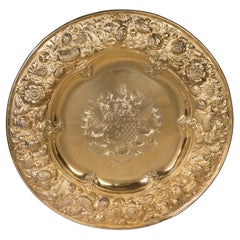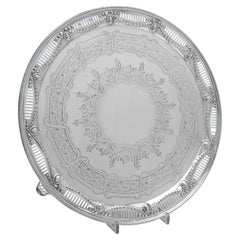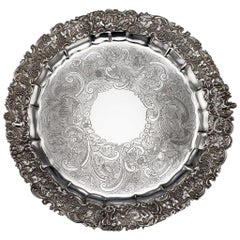Items Similar to Important Rothschild family French silver presentation plate by Maurice Mayer
Want more images or videos?
Request additional images or videos from the seller
1 of 13
Important Rothschild family French silver presentation plate by Maurice Mayer
$8,000
£6,009.82
€6,930.30
CA$11,101.04
A$12,335.71
CHF 6,464.04
MX$151,275.47
NOK 82,445.09
SEK 77,561.31
DKK 51,724.84
Shipping
Retrieving quote...The 1stDibs Promise:
Authenticity Guarantee,
Money-Back Guarantee,
24-Hour Cancellation
About the Item
extremely rare french silver presentation plate/ dinner plate.
this important plate is one of the best quality work and engraving i have ever seen in my life, the outer rim is all adorned
and ornate with flowers in neoclassical style, and the actual plate is all hand engraved with the most incredible engraving with gold plating on just the engraved patterns what makes the plate looks like the gold plated part is 3 dimensional.
This important plate was made in paris by the famous silver master Maurice Mayer who was a highly decorated goldsmith of the 3rd quarter of the 19th century, he was active since 1846 until 1870, he designed silverware for the court of napoleon III, And in 1855 he was awarded the 1st class medal, his works are exhibited in museums across the world, even the jewish museum in New York.
This rare plate was made for the Rothschild family by Mayer in Paris, it was probably commissioned by for use in their home or maybe for presentation, either way, this is a piece of jewish royalty, Rothschild family commissioned items are very rare to find because the family is still alive and working so must of their treasures and art is still in the family.
This plate has the full coat of arms granted the barons Rothschild in 1822 by emperor Francis I of Austria:
Crest
Crests: 1st, out of a ducal coronet Or a mullet of six points Or between two horns per fess alternately Or and Sable, Sable and Or; 2nd, issuant from a ducal coronet Or an eagle displayed Sable; 3rd, out of a ducal coronet Or three ostrich feathers, the centre one Argent and the exterior ones Azure
Escutcheon
Quarterly: 1st, Or an eagle displayed Sable langued Gules; 2nd, Azure issuing from the sinister flank an arm embowed proper grasping five arrows points downward Argent; 3rd, Azure issuing from the dexter flank an arm embowed proper grasping five arrows points downward Argent; 4th, Or a Lion rampant Gules; over all an escutcheon Gules charged with an oval target with pointed center Argent per bend sinister
Supporters
Dexter: a lion rampant Or langued Gules
Sinister: a unicorn Argent langued Gules
Motto
Concordia, Integritas, Industria (latin for "Harmony, Integrity, Industry")
The Rothschild family :
Is a wealthy Ashkenazi Jewish family originally from Frankfurt that rose to prominence with
Mayer Amschel Rothschild (1744–1812), a court factor to the German Landgraves of Hesse-Kassel in the Free City of Frankfurt, Holy Roman Empire, who established his banking business in the 1760s. Unlike most previous court factors, Rothschild managed to bequeath his wealth and established an international banking family through his five sons, who established businesses in London, Paris, Frankfurt, Vienna, and Naples. The family was elevated to noble rank in the Holy Roman Empire and the United Kingdom.
The family's documented history starts in 16th century Frankfurt; its name is derived from the family house, Rothschild, built by Isaak Elchanan Bacharach in Frankfurt in 1567.
During the 19th century, the Rothschild family possessed the largest private fortune in the world, as well as in modern world history. The family's wealth declined over the 20th century, and was divided among many descendants. Today, their interests cover a diverse range of fields, including financial services, real estate, mining, energy, agriculture, winemaking, and nonprofits.Many examples of the family's rural architecture exist across northwestern Europe.
James de Rothschild was born in Frankfurt-am-Main, then part of the Holy Roman Empire. He was the fifth son and youngest child of Mayer Amschel Rothschild (1744–1812) and Guttle Schnapper (1753–1849).
In 1812, he moved to Paris to co-ordinate the purchase of specie and bullion for his brother
Nathan Mayer Rothschild (1777–1836), and in 1814 and 1815 he was the linchpin in Nathan's plan to furnish Wellington's armies with funds. In 1817 he expanded the family banking empire to the city, opening De Rothschild Frères. By 1823 the Paris House was firmly established as banker to the French government.
An adviser of ministers and kings, he became the most powerful banker in the country and following the Napoleonic Wars, played a major role in financing the construction of railroads and the mining business that helped make France an industrial power. Along the way, he added to his fortune with investments in such things as the importation of tea and the wine industry. A strong-willed and shrewd businessman, de Rothschild amassed a fortune that made him one of the richest men in the world.
In 1822 de Rothschild, along with his four brothers, was awarded the hereditary title of "Freiherr" (Baron) by Emperor Francis I of Austria. That same year he was appointed consul-general of the Austrian Empire and in 1823 was awarded the French Legion of Honour.
Following the July 1830 Revolution that saw King Louis Philippe come to power, de Rothschild put together a loan package to stabilize the finances of the new government, and in 1834 a second loan. In gratitude for his services to the French nation, Louis Philippe elevated him to the dignity of Grand Officer of the Legion of Honour.
King Louis Philippe was forced to abdicate after the outbreak of the French Revolution of 1848. Under Emperor Napoleon III, de Rothschild lost part of his political influence, however, despite some difficulties, the family business survived and prospered under the new regime. Since 1852 he had also to defend the attacks of the bank Crédit Mobilier. The conflict between the Rothschilds and the rival company also spread to other countries. De Rothschild succeeded in maintaining the leading position of his house.
In addition to his banking business, in 1868 de Rothschild purchased Château Lafite, one of France's most outstanding vineyards. Located in the Bordeaux region, it is a business that remains in the family to this day.
- Dimensions:Height: 1.5 in (3.81 cm)Diameter: 9.4 in (23.88 cm)
- Style:Neoclassical (In the Style Of)
- Materials and Techniques:
- Place of Origin:
- Period:
- Date of Manufacture:1870
- Condition:This plate is in an amazing condition for its age, no dents or restoration, some minor age wear but nothing other than that.
- Seller Location:Tel Aviv - Jaffa, IL
- Reference Number:1stDibs: LU8130237709302
About the Seller
No Reviews Yet
Vetted Professional Seller
Every seller passes strict standards for authenticity and reliability
1stDibs seller since 2023
- ShippingRetrieving quote...Shipping from: Tel Aviv - Jaffa, Israel
- Return Policy
Authenticity Guarantee
In the unlikely event there’s an issue with an item’s authenticity, contact us within 1 year for a full refund. DetailsMoney-Back Guarantee
If your item is not as described, is damaged in transit, or does not arrive, contact us within 7 days for a full refund. Details24-Hour Cancellation
You have a 24-hour grace period in which to reconsider your purchase, with no questions asked.Vetted Professional Sellers
Our world-class sellers must adhere to strict standards for service and quality, maintaining the integrity of our listings.Price-Match Guarantee
If you find that a seller listed the same item for a lower price elsewhere, we’ll match it.Trusted Global Delivery
Our best-in-class carrier network provides specialized shipping options worldwide, including custom delivery.More From This Seller
View AllDecorative Judaica Passover plate by Heinrich Schwed. Munich, 1924.
Located in Tel Aviv - Jaffa, IL
Decorative Passover plate by Heinrich Schwed. Munich, 1924.
ALPACA, etched.
This Large plate, featuring a round medallion in the center, with a Matzah which in this plate is hand c...
Category
Vintage 1920s Platters and Serveware
Materials
Alpaca
Spanish Toledo Gold Inlaid Damascene Iron plate, islamic art, Felipa Madrid 1894
Located in Tel Aviv - Jaffa, IL
This is a rare chance to own a piece of important "ZULOAGA WARE" (The preservation of damascening in Spain was almost entirely due to the genius of a single family, the Zuloagas ) or "Toledo gold...
Category
Antique 1890s Spanish Islamic Platters and Serveware
Materials
Gold, Iron
$22,000
Free Shipping
Rare George iv Gilt-Silver Inkwell, Rundell and Bridge
By Rundell, Bridge & Rundell
Located in Tel Aviv - Jaffa, IL
Very rare and important piece of George IV silver, highly important silver-gilt Inkwell probably by John Bridge of the renowned silversmiths Rundell & Bridge, Royal Silversmiths to t...
Category
Antique 1820s English Sterling Silver
Materials
Gold Plate, Silver
Rare early Bezalel Jerusalem JUDAICA etched brass garden of eden plate
Located in Tel Aviv - Jaffa, IL
very rare Bezalel Jerusalem plate , this amazing plate has the best subject And artistic Design i have seen in a lot of years, the plate has 5 different scenes from the story Of Adam And Eve in the garden pf Eden.
On the middle of the plate the is an Hebrew inscription, it is parts from the 5 lines that describe The 5 scene on the plate:
"וַיִּ֩יצֶר֩ אֶת־הָֽאָדָ֗ם עָפָר֙ מִן־הָ֣אֲדָמָ֔ה"
"And the Lord God formed man of dust from the ground"
"לֹא־ט֛וֹב הֱי֥וֹת הָֽאָדָ֖ם לְבַדּ֑וֹ"
"And the Lord God said, "It is not good that man is alone"
"'וַיִּֽהְי֤וּ שְׁנֵיהֶם֙ עֲרוּמִּ֔ים"
"Now they were both naked"
"וַתִּקַּ֥ח מִפִּרְי֖וֹ וַתֹּאכַ֑ל וַתִּתֵּ֧ן גַּם־לְאִישָׁ֛הּ"
"She took of its fruit, and she ate, and she gave also to her husband"
"וַיְגָ֖רֶשׁ אֶת־הָֽאָדָ֑ם וַיַּשְׁכֵּן֩ מִקֶּ֨דֶם לְגַן־עֵ֜דֶן אֶת־הַכְּרֻבִ֗ים וְאֵ֨ת לַ֤הַט הַחֶ֨רֶב֙ הַמִּתְהַפֶּ֔כֶת לִשְׁמֹ֕ר אֶת־דֶּ֖רֶךְ עֵ֥ץ הַֽחַיִּֽים:"
"And He drove the man out, and He stationed from the east of the Garden of Eden the cherubim and the blade of the revolving sword, to guard the way to the Tree of Life."
This rare plate is fully marked on the back "BEZALEL JERUSALEM" in Hebrew, the Jerusalem Mark is a bit worn but it is present, on the top of the mark there is the number 522 which is Probably the model number, this plate was mad on the early 1910s or even earlier and it is one of Bezalel earliest works, it is not known who is the artist but the artistic style is typical of Reuben Leaf Lipschitz, he was working in Bezalel in 1912-1916 and was the manager of the etching Department in this time frame, in 1916 he moved to the USA to escape joining the ottoman army in ww1. he stayed in the USA and became a graphic designer who designed and decorated Synagogues he also made graphic designs a illustrations to Hebrew books...
Category
Vintage 1910s Israeli Arts and Crafts Decorative Dishes and Vide-Poche
Materials
Brass
A Rare imperial Russian silver and onyx figural tray, 1st Kiev Artel, 1908-1917
Located in Tel Aviv - Jaffa, IL
Amazingly rare ashtray or a small trinket bowl, made in the early 20th century by the Important and high quality First Kiev Artel, The First Kiev Artel was founded in 1900 and Produced a wide variety of silver vessels as well as decorations. The quality of its work is Indicated in part by the fact that Fabergé’s Kiev branch hired away several artel members Between 1905 and 1910 and was absorbed by the Kiev branch of Fabergé .
The workshop, which counted forty workers by 1909, was considered one of the best for Production of jewelry items from this important workshop are amazingly scarce and Hard To find, and only a handful of the works ever made it to public auctions.
This bowl is constructed from a carved green onyx...
Category
Antique Early 1900s Sterling Silver
Materials
Onyx, Silver
Important Early 20th Century Silver Kiddush Goblet by Bezalel School Jerusalem
Located in Tel Aviv - Jaffa, IL
Important Handmade sterling silver Kiddush goblet by Bezalel School, Jerusalem, circa 1910-1913.
On round base decorated with silver filigree and Cabouchon shaped green agate applications.
The base fitted with Bezalel mark. The upper portion is all adorned with amazing filigree work, the base and the actual cup adorned with swirling filigree designs, in the middle there are 3 roundels, made in another technique of hammered silver, similar to the works that were produced in this time all over Europe, in the middle of each roundel there is a perfectly centered Cabouchon green agate.
This work is attributed to Yehia Yemini.
The goblet is marked on the base, with the earliest silver mark of the school that just say "Bezalel" in Hebrew.
Yehia Yemini :
Was one of the biggest and must famous Bezalel silver...
Category
Early 20th Century Israeli Jugendstil Sterling Silver
Materials
Silver
You May Also Like
Rothschild "Poetry" Silver Gilt Salver by Elkington & Co.
By Elkington & Co.
Located in New Orleans, LA
Silver Gilt Salver
Elkington & Co.
Hallmarked Birmingham, 1889
Remarkable provenance, breathtaking artistry and exceptional rarity make this majestic silver gilt salver by Elkington...
Category
Antique 19th Century English Renaissance Revival Platters and Serveware
Materials
Silver, Sterling Silver
William IV Period Silver Gilt Charger Dish by Robert Garrard II with Provenance
By Robert Garrard II 1
Located in London, GB
A Massive Silver Gilt Sideboard Dish
By Robert Garrard II
A splendid circular sideboard dish with a broad border, finely repoussé and chased in high relief with an intricate array o...
Category
Antique 19th Century English Sterling Silver
Materials
Vermeil
Victorian sterling silver salver made in London 1868 by Martin & Hall
By Martin & Hall
Located in London, London
Hallmarked in London in 1868 by Martin & Hall, this very attractive, Victorian Antique Sterling Silver Salver, features a pierced border, 3 feet, and wonderful engraved decoration to...
Category
Antique 1860s English Victorian Platters and Serveware
Materials
Sterling Silver
19th Century Regency Solid Silver Magnificent Salver Tray, J Hayne, circa 1827
By Jonathan Hayne
Located in Royal Tunbridge Wells, Kent
Antique 19th century rare and exceptional George IV solid silver salver tray with cast border, large size and extremely heavy gauge, of shaped-circular form with applied cast border ...
Category
Antique 19th Century English George IV Decorative Dishes and Vide-Poche
Materials
Sterling Silver
From a German Royal Household Large Serving-Plate 800/0 Silver Germany 1900
Located in Berlin, DE
This beautifully handcrafted serving-plate made of 800/0 Silver in Münster, Germany by Jewellers Osthues, circa 1900 will be an eyecatcher on any festive table.
The elegant rim is „D...
Category
Antique Early 1900s European Victorian Silver Chargers and Plates
Materials
Silver
$3,353 Sale Price
20% Off
Free Shipping
Footed Sterling Silver Salver London, 1861
By Robert Hennell
Located in Tunbridge Wells, GB
Footed Sterling Silver Salver London, 1861
Additional information:
Date : Hallmarked in London, 1861 for Robert Hennell
Period : Victoria
Origin : Londo...
Category
Antique 19th Century English Victorian Sheffield and Silverplate
Materials
Sterling Silver

